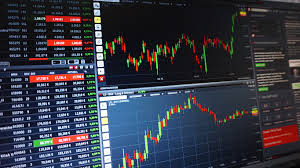Asian stocks still in red after some recovery with fresh US-Sino trade conflict

Asian shares staggered up from five-week lows on Tuesday but remained fragile after U.S. President Donald Trump's latest threat to raise tariffs on Chinese goods shocked financial markets and fueled worries that trade talks may be derailed. MSCI's broadest index of Asia-Pacific shares outside Japan edged up 0.1 per cent, erasing earlier losses. It tumbled 2 per cent on Monday after Trump unexpectedly jacked up pressure on Beijing in the midst of trade negotiations.
Chinese shares staged a mild technical rebound but stayed choppy after their worst drop in more than three years on Monday. The benchmark Shanghai Composite was 0.5 per cent higher, while the blue-chip CSI 300 rose 0.7 per cent and Hong Kong's Hang Seng was up 0.3 per cent. Japan's Nikkei shed 1.5 per cent, taking a delayed hit as the country's financial markets opened on Tuesday after a 10-day break to mark the ascension of a new emperor.
Financial spread-betters expect London's FTSE, Frankfurt's DAX and Paris's CAC to fall between 0.1 and 0.3 per cent when they open. U.S. stock futures for the S&P 500 declined as much as 0.8 per cent in Asian trading hours on Tuesday as top U.S. officials said China had backtracked on commitments in trade talks.
Trump tweeted on Sunday that he would raise tariffs on $200 billion worth of Chinese goods to 25 per cent from 10 per cent by the end of the week and would "soon" target the remaining Chinese imports with tariffs, prompting investors to dump risky assets on Monday. Yasuo Sakuma, chief investment officer at Libra Investments in Tokyo, believed stocks have entered a new downtrend as investors had growing doubts over whether the United States and China would cut a deal on trade any time soon.
"Investors had been too complacent since the beginning of this year. Now it's time for 'sell in May and go away,'" he said. Still, some investors are holding out hope that the tariff threats are a negotiating tactic.
U.S. Trade Representative Robert Lighthizer said he expected top Chinese negotiator Vice Premier Liu He would lead a delegation coming from Beijing for talks in Washington on Thursday and Friday. "Markets are still not sure (whether Trump will go ahead with the tariff hikes,) and far from a panicky situation. We have to see how the U.S.-China talks will unfold this week," said Naoki Iwami, fixed income chief investment officer at Whiz Partners.
China' yuan weakened further against the dollar on Tuesday, but the pace of losses slowed, as investors largely digested Trump's tariff threats and started to seek clues for the reaction from Beijing. The offshore yuan slipped 0.3 per cent to 6.7939 per dollar while the onshore yuan also fell 0.3 per cent to 6.7789 per dollar.
Australia's dollar became the biggest mover among the major currencies, strengthening as much as 0.9 per cent to a one-week top of $0.7048, after the country central bank's decision to hold rates wrongfooted some who had expected a cut. There had been some speculation it would ease policy given recent weak inflation.
Other major currencies remained confined to well-trodden ranges on Tuesday, with the euro trading virtually flat at $1.1212 and the dollar holding steady at 110.63 yen. In the commodity market, oil futures traded steady to higher on Tuesday as U.S. sanctions on crude exporters Iran and Venezuela kept supply concerns alive. U.S. West Texas Intermediate (WTI) crude futures inched up to $62.34 per barrel while Brent crude oil futures were little changed at $71.23.
(With inputs from agencies.)
ALSO READ
US military says it destroyed Houthi missile likely targeting a ship in Gulf of Aden
Paul Simon to play for Japan's Kishida, Bidens at White House state dinner
US considers easing warnings for Americans traveling to China
FACTBOX-US, Japan to strike deals on defense, space at leaders' summit
India US partnership reaches unprecedented levels: Sullivan.










